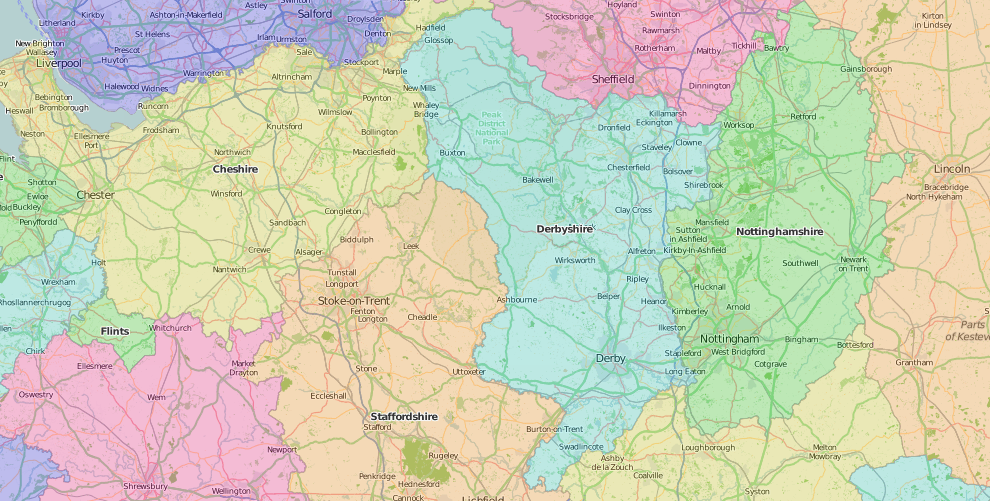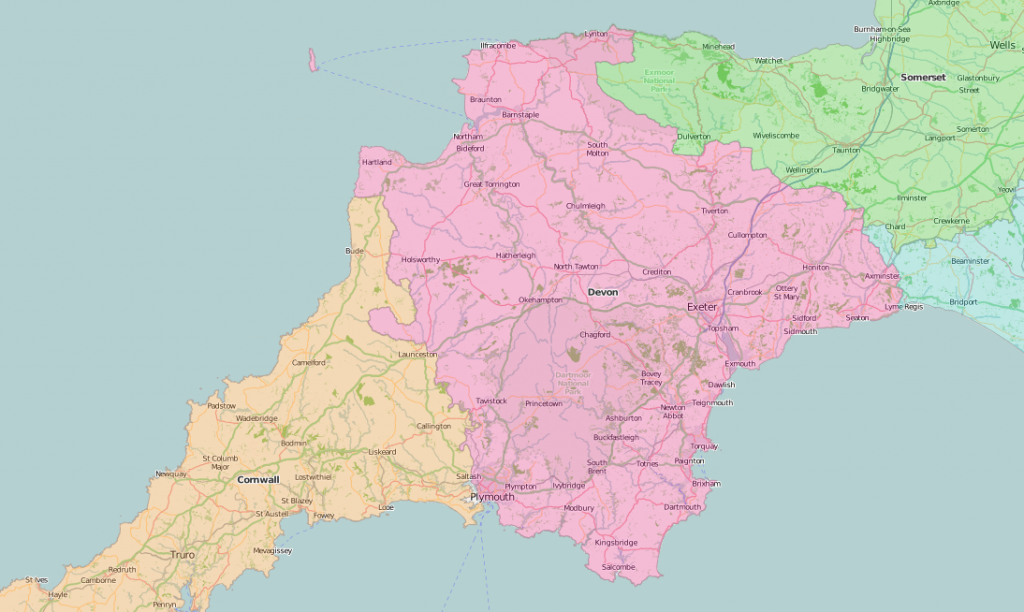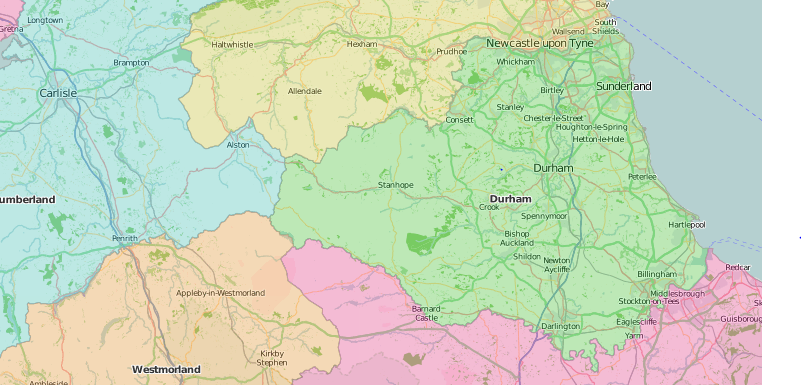
From Devonshire dumplings via Dorset to the ‘minecraft’ of Derbyshire and Durham.
John Speed’s Derbyshire map shows 36 deer parks, clustered to the east and south of the “black and mossy ground” of the High Peak. Buxton spa is depicted, as well as the town plan of ‘Darbye’. Derbyshire landscapes, and the rocks which formed them, feature in a number of our Special Collections: The Buxton diamonds; or, Grateful Ellen: for the amusement and instruction of children (1820) was published by the famous firm of William Darton, as were more than 50 other titles in the Children’s book collections. A century later, the Derbyshire dales were celebrated in the poetry of Brenda Murray Draper (1880-1962): The dales of Derbyshire (1920), was a gift from the author to Katharine Bruce Glasier, who celebrated the area in her own Tales from the Derbyshire hills: pastorals from the Peak District (1907). Both pamphlets are part of the Glasier Papers. Local geology is the subject of both Anthony Tissington’s 18th century Letter to a friend on the mineral customs of Derbyshire … By a Derbyshire working miner (1766) and William Martin’s 1809 Petrificata derbiensia; or, Figures and descriptions of petrifactions collected in Derbyshire, which could be bought from the author in Buxton.

Devonshire is famous for its seafarers, including the slaver Sir John Hawkins (1532-1595), and Sir Francis Drake (1540-1596), both contemporaries of Speed (1551/2-1629), as was Tristram Risdon (c.1580-1640). Risdon’s manuscript account of his county has a usefully descriptive title: Chorographical description or survey of the county of Devon, with city and county of Exeter; containing matter of history, antiquity, chronology, the nature of the country, commodities and government thereof with sundry other things worthy of observation. Collected by the travail of Tristram Risdon of Winscot, gent, for the love of his country and countrymen. The manuscript circulated for nearly a century before its first, inaccurate, publication by Edmund Curll in 1714. Another century on, Plymouth publishers Rees & Curtis produced a much better version (1811). Devon’s famous faces were celebrated in the republication, in 1810, of John Prince’s 1701 Danmonii orientales illustres; or, The worthies of Devon. A work, wherein the lives and fortunes of the most famous divines, statesmen, swordsmen, physicians, writers, and other eminent persons, natives of that most noble province, from before the Norman conquest, down to the present age, are memorized … out of the most approved authors, both in print and manuscript. The siege of Plymouth during the English Civil War is recounted for children in Mrs Paull’s Benjamin Holbeck: a story of the siege of Plymouth, although Benjamin has actually travelled from Yorkshire to take up the cause alongside his father. There are more tales of derring-do by children visiting Devon (from London) in Mrs Paull’s Six Devonshire dumplings (1910?). Or the county’s sights can be safely enjoyed at a distance in Besley’s views of Devonshire, published in Exeter, c.1853.

Next-door Dorset has its own delights for children, including the singing games collected by Alice Gillington (1863-1934), who shared with fellow Gypsy Lore Society members their fascination with Romany culture, and atttempts to adopt aspects of the travelling life. Her last collection, Old Dorset singing games (1913) including some from Wiltshire and the New Forest, may include some from the Gypsies she lived alongside. Two of the best-known are The Mulberry Bush and Oranges and Lemons. Alice Gillington spent much of her life living in caravans, and died on a caravan site near Poole. The famous local poet William Barnes (1801-1886) captured another aspect of Dorset in his Poems of rural life, in the Dorset dialect with a dissertation and glossary (1844, first edition). The Summer poem ‘Haven oon’s Fortun a-tuold’ evokes Romany Gypsy customs.

The County Palatine of Durham, like the County Palatine of Chester, is border territory, and Speed’s map includes an episode from its already long history of warfare – a picture of the battle of Neville’s Cross. More peaceful pursuits are recorded in Dinsdale’s Glossary of provincial words used in Teesdale in the County of Durham (1849). And the splendours of Durham architecture, especially its cathedral, are described in numerous works: Winkles’s architectural and picturesque illustrations of the cathedral churches of England and Wales (1851-1860) featured Durham in volume three of a new edition, which added Manchester cathedral; Robert Billings devoted an entire work to Durham Cathedral in 1843; but Robert Surtees made a lifetime’s work of his weighty four-volume History and antiquities of the County Palatine of Durham; compiled from original records, preserved in public repositories and private collections: and illustrated by engravings of architectural and monumental antiquities, portraits of eminent persons, etc. (1816-1840). Returning to maps, Durham was surveyed twice for the General Views series, by Joseph Granger in 1794 and again by John Bailey (1750-1819) who toured the county from 1807-1809. Bailey’s account of its ‘geographical state and circumstances’ includes a hand-coloured soil map marking the coal mines by heavy dots.
Special Collections classmarks:
Derbyshire:
- The Buxton diamonds; or, Grateful Ellen: for the amusement and instruction of children (London, William Darton, approximately 1823: JUV.A659)
- Brenda Murray Draper (1880-1962), The dales of Derbyshire; and other poems (Burton-on-Trent, The author, 1920: SPEC GP/6/2/17)
- Katharine Bruce Glasier, Tales from the Derbyshire hills (Independent Labour Party, 1907: SPEC GP/6/1/62)
- Anthony Tissington, A letter to a friend on the mineral customs of Derbyshire … By a Derbyshire working miner (London, printed for the author, 1766: SPEC Knows. pamph 253)
- William Martin (1767-1810), Petrificata derbiensia; or, Figures and descriptions of petrifactions collected in Derbyshire (Wigan, 1809: SPEC G47.38)
Devon
- John Prince, Danmonii orientales illustres; or, The worthies of Devon.(1810: SPEC Y81.5.87)
- Tristram Risdon (approximately 1580-1640), The chorographical description or survey of the county of Devon. Printed from a genuine copy of the original manuscript, with considerable additions (1811: SPEC Y81.3.90)
- Mary Anna Paull (1838-1910), Benjamin Holbeck: a story of the siege of Plymouth (date not known: JUV.A151:5)
- Margaret Batchelor, Six Devonshire dumplings (1910? JUV.A239)
- Besley’s Views of Devonshire (1853: SPEC Y85.3.604)
Dorset
- Alice E. Gillington (1863-1934), Old Dorset singing games (1913?: SPEC Scott Macfie A.7.50/6)
- William Barnes (1801-1886), Poems of rural life, in the Dorset dialect with a dissertation and glossary (1844: SPEC Y84.3.413)
Durham
- Frederick T. Dinsdale, Glossary of provincial words used in Teesdale in the County of Durham (1849: SPEC Y84.3.1872)
- Benjamin Winkles, Winkles’s architectural and picturesque illustrations of the cathedral churches of England and Wales; the drawings made from sketches taken expressly for this work; with historical and descriptive accounts (1851-1860: SPEC Y86.3.284)
- Robert William Billings (1813-1874), Architectural illustrations and descriptions of the Cathedral Church at Durham (1843: SPEC Ryl.D.2.24)
- Robert Surtees (1779-1834), The history and antiquities of the County Palatine of Durham; compiled from original records, preserved in public repositories and private collections: and illustrated by engravings of architectural and monumental antiquities, portraits of eminent persons, etc. (1816-1840: SPEC Q20.1-4/oversize)
- John Bailey (1750-1819), General View of the agriculture of the county of Durham (1810: SPEC Y81.3.242)
Map of Durham from Wikishire.co.uk CC-BY-SA.